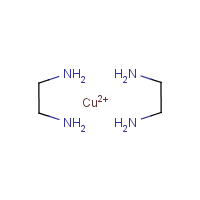Cupriethylenediamine
Agent Name
Cupriethylenediamine
CAS Number
13426-91-0
Formula
C4-H16-Cu-N4
Major Category
Metals

Synonyms
Bis(1,2-ethanediamine-N,N')copper(2+); Bis(ethylenediamine)copper ion; Bis(ethylenediamine)copper(2+); Bis(ethylenediamine)copper(2+) ion; Copper(2+), bis(1,2-ethanediamine-N,N')-, (SP-4-1)-; Copper(2+), bis(ethylenediamine)-, ion; Copper-ethylenediamine complex; Cupriethylene diamine; Ethane, 1,2-diamino-, copper complex; Komeen; Koplex aquatic herbicide; [ChemIDplus] UN1761
Category
Organic Compounds, Metal Salts
Description
Purple liquid with an ammoniacal odor; [HSDB] Bluish liquid with an amine-like odor; [MSDSonline]
Sources/Uses
Used as a cellulose and cotton solvent; Older pesticide: fungicide and molluscicide; [HSDB] Classified as a herbicide and agricultural chemical; [ChemIDplus] Used to dissolve cellulose products; [NJ-HSFS]
Comments
A strong irritant; May cause corneal injury; [HSDB] A skin, mucous membrane, and severe eye irritant; May cause asthma and corneal injury; [CAMEO] A corrosive substance that can cause injury to the skin, eyes, and respiratory tract; A lachrymator; May cause severe corneal injury and permanent vision impairment; May cause skin and respiratory sensitization after prolonged contact; Targets liver and kidneys; [MSDSonline] See "Copper." See "Ethylenediamine."
Biomedical References
Exposure Assessment
TLV (ACGIH)
1 mg/m3, as Cu
PEL (OSHA)
1 mg/m3, as Cu
MAK
0.01 mg/m3, respirable fraction (Cu, inorganic cmpnds)
IDLH (NIOSH)
100 mg/m3, as Cu
Explanatory Notes
The Guide in the Emergency Response Guidebook is for "Cupriethylenediamine, solution."
Adverse Effects
Anemia
Aplastic anemia
Skin Sensitizer
Yes
Asthma
Yes
Lachrymator
Yes
Toxic Pneumonitis
Yes
Methemoglobinemia
MetHgb is secondary toxic effect
Hepatotoxin
Hepatoxic (a) from occupational exposure (secondary effect) or (b) in animal studies or in humans after ingestion
Nephrotoxin
Yes
Dermatotoxin
Skin burns
Diseases, Processes, and Activities Linked to This Agent
Diseases
Occupational diseases associated with exposure to this agent:
Processes
Industrial Processes with risk of exposure: